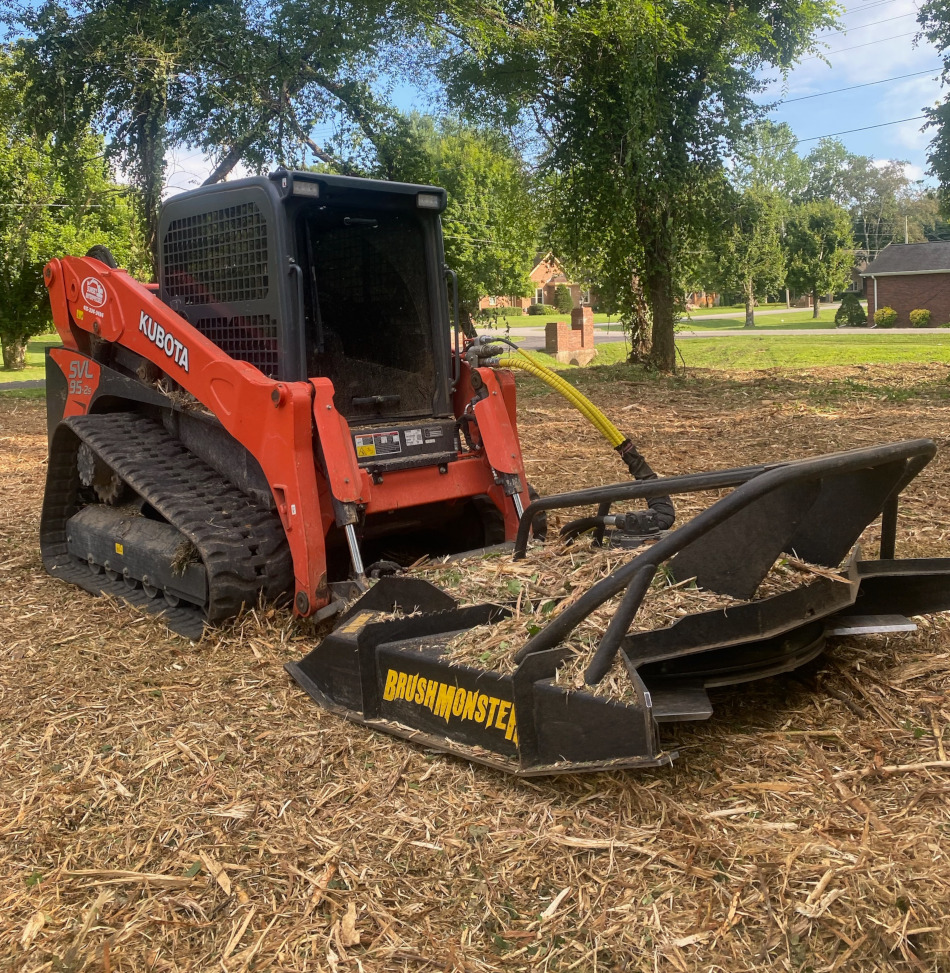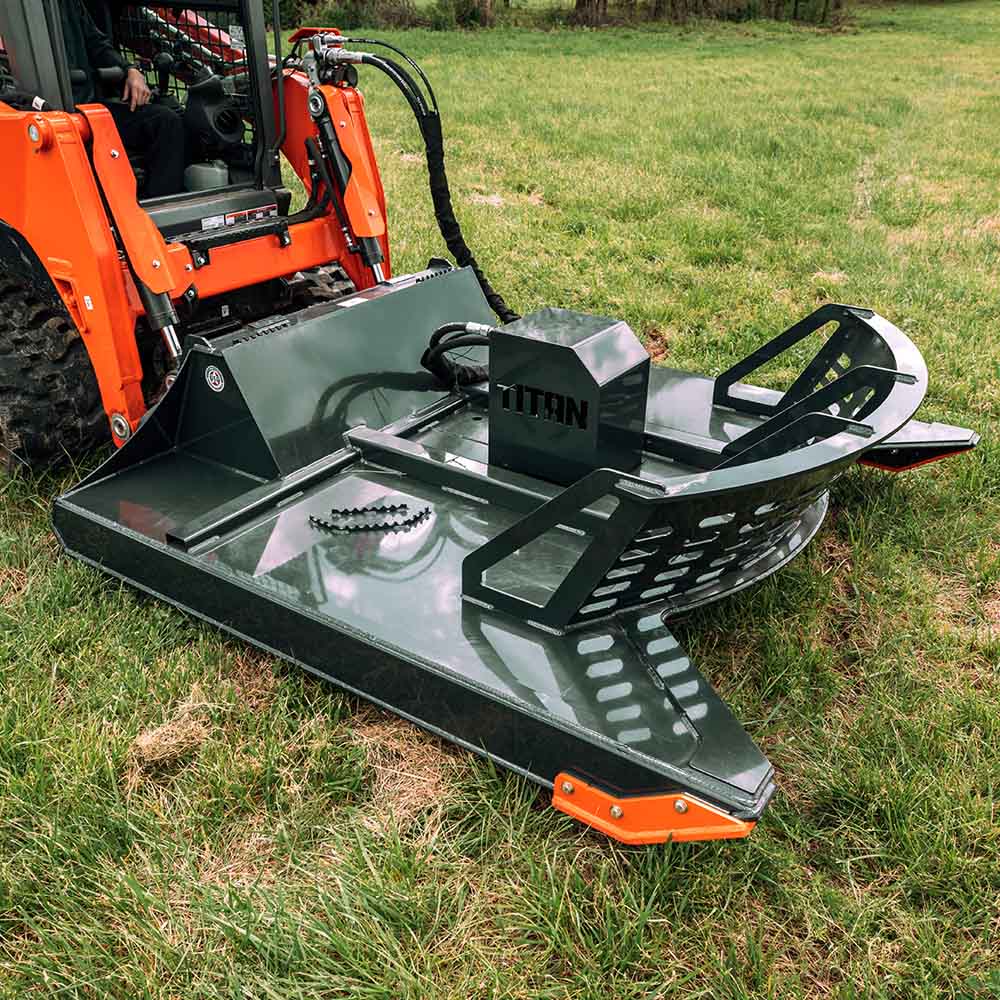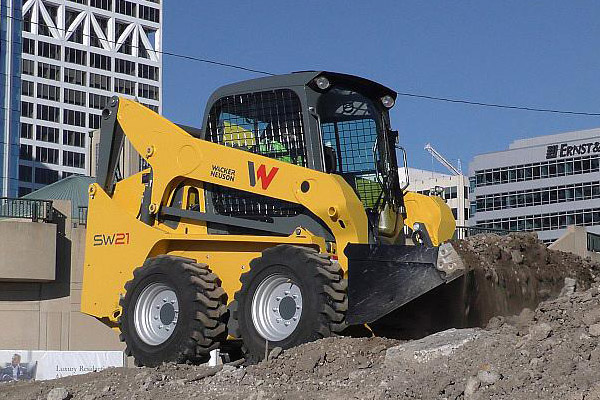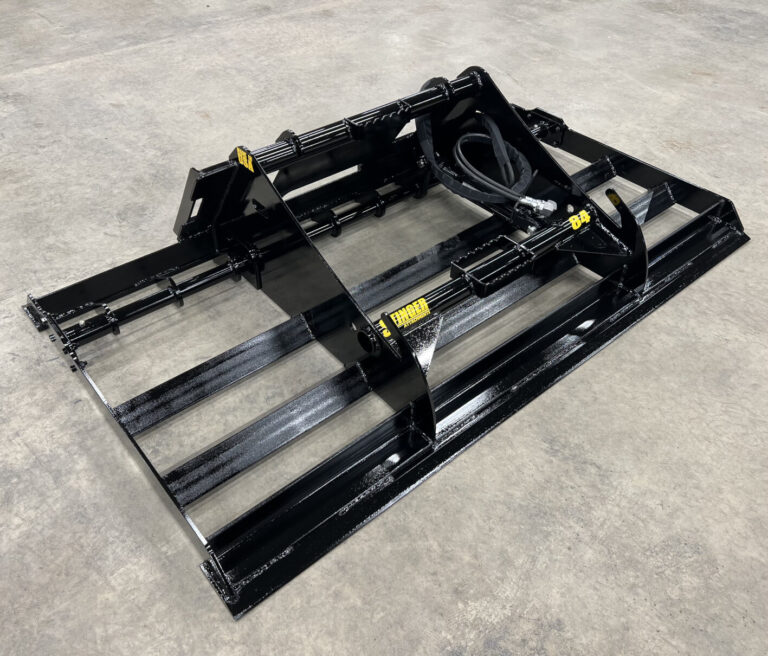Brush Cutter for Skid Steer: Ultimate Clearing Guide
A brush cutter for skid steer is an attachment designed to clear dense vegetation and underbrush. It enhances the versatility and efficiency of skid steer loaders.
Brush cutters are essential tools for land clearing and maintenance tasks. They allow operators to tackle overgrown areas quickly and effectively. These attachments are perfect for both residential and commercial use, providing a clean and professional finish. Their powerful blades can handle tough materials, making them ideal for clearing brush, tall grass, and small trees.
With the right brush cutter, skid steers can transform from simple loaders into robust land management machines. Choosing the right model ensures optimal performance and longevity, making brush cutters a smart investment for anyone needing to manage dense vegetation efficiently.

Credit: skidsteersdirect.com
Introduction To Skid Steer Brush Cutters
Skid steer brush cutters are essential tools for land management. They help clear overgrown areas quickly and efficiently. These attachments turn a skid steer into a powerful cutting machine.
The Rise Of Skid Steers In Land Management
Skid steers have become popular in land management. Their versatility makes them ideal for various tasks. Here are some reasons for their rise:
- Compact Size: Fits into tight spaces easily.
- Powerful Performance: Delivers high power-to-weight ratio.
- Multiple Attachments: Can switch tools for different jobs.
- Cost-Effective: Reduces labor and equipment costs.
Land managers appreciate their efficiency. They handle tough terrains and heavy vegetation without hassle.
Brush Cutter Attachments: Transforming The Landscape
Brush cutter attachments enhance skid steers. They transform landscapes by clearing brush, grass, and small trees.
| Feature | Description |
|---|---|
| Cutting Width | Ranges from 48 to 72 inches. |
| Blade Type | Includes high-strength steel blades. |
| Weight | Typically weighs between 600 to 1,200 pounds. |
| Hydraulic Flow | Requires 15 to 30 GPM for optimal performance. |
Brush cutters can tackle tough jobs effectively. They clear fields, trails, and roads, making them safer and more accessible.
Using a brush cutter attachment saves time and effort. Landowners can reclaim their spaces quickly and efficiently.

Credit: blog.virnigmfg.com
Types Of Brush Cutters For Skid Steers
Brush cutters for skid steers come in various types. Each type serves a unique purpose. Understanding these types helps in making the right choice.
Rotary Cutters: The Spinning Force
Rotary cutters are known for their powerful performance. They have a spinning blade that cuts through thick brush. Here are some key features:
- Versatile Use: Ideal for clearing large areas.
- Speed: Fast cutting reduces time on the job.
- Durability: Built to withstand tough conditions.
These cutters work well on uneven terrain. They are perfect for farms and construction sites. The rotating blades can tackle dense vegetation with ease.
Flail Mowers: Precision Cutting
Flail mowers offer a different approach. They use a series of small blades attached to a rotor. This design allows for precise cutting. Key benefits include:
- Fine Mulching: Cuts grass and small branches finely.
- Safety: Less debris thrown around during operation.
- Control: Excellent for trimming near obstacles.
Flail mowers are great for manicured lawns. They maintain a clean look while ensuring healthy growth.
Mulchers: The Heavy-duty Clearers
Mulchers are the heavyweights in brush cutting. They grind down large brush and trees. Their robust design makes them suitable for tough jobs. Here are their main features:
- Powerful Performance: Can handle trees up to 12 inches in diameter.
- Efficiency: Turns brush into mulch quickly.
- Versatile: Works on various types of terrain.
These are perfect for land clearing projects. Mulchers create a clean area ready for new growth.
| Type | Best For | Key Features |
|---|---|---|
| Rotary Cutters | Large Areas | Speed, Versatility, Durability |
| Flail Mowers | Precision Cutting | Fine Mulching, Safety, Control |
| Mulchers | Heavy-Duty Clearing | Powerful Performance, Efficiency, Versatile |
Key Features To Consider
Choosing the right brush cutter for your skid steer is essential. Several features affect performance and durability. Here are the key aspects to consider.
Blade Quality And Material
The blade is the heart of a brush cutter. High-quality blades ensure effective cutting. Consider these factors:
- Material: Look for hardened steel or carbide-tipped blades.
- Thickness: Thicker blades provide better durability.
- Design: Sharp, angled blades cut through tough vegetation easily.
Choose blades that suit your specific cutting needs. Proper blade quality leads to fewer replacements.
Hydraulic Flow Requirements
Hydraulic flow affects the efficiency of the brush cutter. Check the following:
| Hydraulic Flow Rate | Recommended Power |
|---|---|
| 10-15 GPM | 5-10 HP |
| 15-20 GPM | 10-15 HP |
| 20-30 GPM | 15-25 HP |
Matching the hydraulic flow with the brush cutter ensures optimal performance. It prevents damage and increases efficiency.
Durability And Design
Durability is critical for long-term use. A well-designed brush cutter withstands tough conditions. Focus on these aspects:
- Frame Material: Look for heavy-duty steel frames.
- Weight: Heavier models often provide better stability.
- Protection: Shields and guards help protect internal components.
A sturdy design reduces maintenance costs. Choose a brush cutter that can handle various terrains.
Safety Measures And Precautions
Operating a brush cutter for skid steer can be dangerous. Proper safety measures protect operators and bystanders. Understanding these precautions is essential for safe and efficient operation.
Operator Protection Strategies
Protecting the operator is crucial. Follow these strategies for safety:
- Wear Protective Gear: Always wear a helmet, gloves, and goggles.
- Use Ear Protection: Brush cutters can be loud. Protect your hearing.
- Secure Loose Clothing: Avoid clothing that can get caught in machinery.
- Stay Aware of Surroundings: Keep an eye on nearby people and obstacles.
- Use Proper Footwear: Sturdy boots can prevent slips and falls.
These strategies reduce the risk of injury during operation. Always stay alert and focused.
Maintenance And Care For Safe Operations
Regular maintenance ensures safe operation of the brush cutter. Follow these tips for effective care:
| Maintenance Task | Frequency | Description |
|---|---|---|
| Check Blades | Before each use | Ensure blades are sharp and not damaged. |
| Inspect Fuel Lines | Weekly | Look for leaks or cracks in fuel lines. |
| Clean Filters | Every month | Keep filters clean for optimal performance. |
| Check Oil Levels | Before each use | Maintain proper oil levels for engine health. |
Regular maintenance prevents accidents and improves performance. Always follow the manufacturer’s guidelines.
How To Attach And Use A Brush Cutter
Attaching and using a brush cutter on a skid steer can enhance your landscaping tasks. This powerful tool makes clearing brush easy and efficient. Follow these steps to ensure proper attachment and use.
Step-by-step Attachment Process
- Park the Skid Steer: Ensure the machine is on a flat surface.
- Turn Off the Engine: Safety first! Always turn off the engine.
- Locate the Mounting Plate: Find the attachment points on the skid steer.
- Align the Brush Cutter: Position the brush cutter with the mounting plate.
- Secure the Attachment: Use the pins and clips to lock it in place.
- Check Connections: Ensure everything is tightly secured.
- Start the Engine: Turn on the skid steer and engage the cutter.
Operating Tips For Maximum Efficiency
- Maintain Speed: Keep a steady speed for a clean cut.
- Adjust Height: Set the cutter at the right height for the job.
- Clear Debris: Regularly check for tangles or obstructions.
- Use Protective Gear: Always wear gloves and goggles.
- Monitor Fuel Levels: Keep an eye on fuel to avoid interruptions.
| Tip | Description |
|---|---|
| Steady Speed | Consistent speed helps achieve a better cut. |
| Proper Height | Adjust height based on the type of brush. |
| Protective Gear | Use gloves, goggles, and ear protection for safety. |
Follow these steps and tips for an effective brush-cutting experience. Using a brush cutter efficiently saves time and improves landscaping results.
Maintenance And Troubleshooting
Proper maintenance ensures your brush cutter for skid steer lasts longer. Regular checks and quick fixes keep it running smoothly. Understanding maintenance and troubleshooting is key to optimal performance.
Regular Upkeep For Longevity
Routine care helps prevent major issues. Follow these simple steps for effective maintenance:
- Inspect Blades: Check for wear and tear. Replace if damaged.
- Clean After Use: Remove debris and dirt after every job.
- Lubricate Moving Parts: Apply grease to joints and bearings.
- Check Hydraulic Fluid: Maintain proper fluid levels regularly.
- Examine Hoses: Look for cracks or leaks. Replace as needed.
Set a maintenance schedule. This helps catch issues early. A well-maintained brush cutter enhances performance and durability.
Common Issues And How To Fix Them
Brush cutters may face several issues. Knowing how to troubleshoot can save time.
| Problem | Possible Causes | Solutions |
|---|---|---|
| Uneven Cutting | Worn blades or improper height | Sharpen or replace blades. Adjust cutting height. |
| Overheating | Low hydraulic fluid or clogged filters | Check fluid levels. Clean or replace filters. |
| Weak Performance | Dirty air filter or fuel issues | Clean air filter. Check fuel quality. |
Follow these guidelines for quick fixes. Troubleshooting helps you stay productive.
- Read the Manual: Always refer to the manufacturer’s guidelines.
- Keep Spare Parts: Stock common replacement items for quick repairs.
- Ask for Help: Consult a professional for complex issues.
Regular maintenance and troubleshooting skills keep your brush cutter in top shape. Stay proactive for the best results.
Top Brush Cutter Brands And Models
Choosing the right brush cutter for your skid steer is crucial. Many brands offer exceptional quality and performance. Understanding the top brands and their models helps make an informed decision. This guide reviews the best options available in the market.
Industry Leaders In Skid Steer Attachments
Several brands stand out in the brush cutter market. Each offers unique features and advantages:
- Bobcat – Renowned for durability and efficiency.
- Land Pride – Known for versatility and performance.
- Diamond Mowers – Offers robust construction and reliability.
- CAT – Features high-quality engineering and performance.
These brands consistently receive positive reviews from users. They focus on innovation and customer satisfaction.
Comparative Analysis Of Popular Models
Here’s a comparison of popular brush cutter models:
| Brand | Model | Cutting Width | Horsepower Requirement | Weight |
|---|---|---|---|---|
| Bobcat | Brushcat | 60 inches | 30 HP | 800 lbs |
| Land Pride | RTA1242 | 42 inches | 20 HP | 600 lbs |
| Diamond Mowers | Standard Duty | 72 inches | 40 HP | 1,200 lbs |
| CAT | Heavy Duty | 60 inches | 35 HP | 900 lbs |
Each model has specific features that cater to different needs.
- Bobcat Brushcat: Great for tough terrain.
- Land Pride RTA1242: Ideal for smaller jobs.
- Diamond Mowers Standard Duty: Excellent for large areas.
- CAT Heavy Duty: Perfect for heavy-duty tasks.
Understanding the specifications helps choose the best model. Assess your requirements based on your projects.

Credit: brushmonster.com
Environmental Considerations
Using a brush cutter for skid steers impacts the environment. Understanding this impact is crucial. Proper practices can enhance clearing while protecting nature.
Balancing Ecosystem Impact
Brush cutters can affect local ecosystems. They clear vegetation, which may disrupt habitats. Here are some key factors to consider:
- Species Protection: Avoid areas with endangered plants or animals.
- Soil Erosion: Excessive clearing can lead to soil loss.
- Water Quality: Vegetation helps filter water. Removing it can harm water sources.
Maintaining a balance is essential. Ensure minimal disruption to wildlife and plants.
Best Practices For Eco-friendly Clearing
Implementing eco-friendly practices helps reduce negative impacts. Follow these best practices:
- Plan Ahead: Survey the area before clearing.
- Selective Clearing: Remove only necessary vegetation.
- Timing: Clear during appropriate seasons to protect wildlife.
- Use Efficient Equipment: Choose low-emission, fuel-efficient machines.
- Restore Vegetation: Replant native species post-clearing.
These steps promote environmental health. They ensure sustainable land management.
Case Studies: Successful Clearing Projects
Brush cutters for skid steers have transformed many clearing projects. These machines tackle dense vegetation easily. Let’s explore successful case studies in two key areas: agricultural land reclamation and forest management.
Agricultural Land Reclamation
Farmers face challenges with overgrown land. Brush cutters help reclaim this land effectively. Here’s how:
- Project Location: Central Valley, California
- Project Goal: Reclaim 50 acres of abandoned farmland
- Vegetation Type: Dense brush and weeds
The team used a skid steer with a brush cutter. They completed the project in just one week. The results were impressive:
| Metric | Before | After |
|---|---|---|
| Visible Area | 10% | 90% |
| Soil Erosion | High | Low |
| Yield Potential | Low | High |
This project improved land usability. Farmers can now grow crops efficiently.
Forest Management And Fire Prevention
Forests need regular maintenance to prevent wildfires. Brush cutters play a vital role in forest management. Here’s a recent project:
- Project Location: Rocky Mountain National Park
- Project Goal: Reduce underbrush in 100 acres
- Vegetation Type: Dense shrubs and small trees
The team used advanced brush cutters on skid steers. They completed the job in three weeks. Results included:
| Metric | Before | After |
|---|---|---|
| Underbrush Density | High | Low |
| Fire Risk | High | Moderate |
| Wildlife Habitat Quality | Poor | Improved |
These efforts reduced fire risks. Wildlife habitats also improved significantly.
Future Trends In Brush Cutting Technology
The field of brush cutting is evolving rapidly. New technologies are emerging to enhance efficiency and effectiveness. These innovations promise to transform how we approach land clearing. Let’s explore what the future holds.
Innovations On The Horizon
Several exciting innovations are shaping the future of brush cutting technology:
- Improved Blade Designs: New materials increase durability and cutting performance.
- Eco-Friendly Solutions: Electric and hybrid brush cutters reduce emissions.
- Smart Sensors: These detect terrain types for optimized cutting.
- Modular Attachments: Allow customization for various land clearing tasks.
| Innovation | Benefits |
|---|---|
| Improved Blade Designs | Higher efficiency and longer lifespan |
| Eco-Friendly Solutions | Reduced carbon footprint |
| Smart Sensors | Better adaptation to different terrains |
| Modular Attachments | Versatility for different tasks |
The Role Of Automation In Land Clearing
Automation is changing the landscape of brush cutting.
- Remote-Controlled Equipment: Operators can control machines from a distance.
- Autonomous Brush Cutters: These machines perform tasks without human intervention.
- Data Analytics: Helps in planning and executing land clearing projects efficiently.
Key benefits of automation include:
- Increased safety for operators.
- Reduced labor costs.
- Faster project completion.
As technology progresses, brush cutting will become more efficient. These trends promise to streamline operations and enhance productivity.
Frequently Asked Questions
What Is A Brush Cutter For Skid Steer?
A brush cutter for skid steer is an attachment designed to clear dense vegetation. It efficiently cuts through thick brush, small trees, and overgrown areas. This tool enhances the versatility of skid steers, making them ideal for landscaping, land clearing, and maintenance tasks on various terrains.
How Does A Skid Steer Brush Cutter Work?
A skid steer brush cutter operates by using rotating blades to slice through vegetation. The attachment connects to the skid steer’s hydraulic system for power. As the blades rotate at high speeds, they efficiently cut through tough materials, allowing for quick and effective land management.
What Are The Benefits Of Using A Brush Cutter?
Using a brush cutter offers several benefits. It saves time and labor compared to manual clearing methods. Additionally, it can handle a variety of terrains and vegetation types. This tool also helps maintain property aesthetics and prevents overgrowth that can damage landscapes or hinder access.
Can I Use A Brush Cutter On All Surfaces?
While a brush cutter is versatile, it’s not suitable for all surfaces. It performs best on uneven, rough terrains with dense vegetation. Avoid using it on hard surfaces like pavement or rocky areas, as this can damage the blades and reduce efficiency.
Always assess the terrain before use.
Conclusion
Choosing the right brush cutter for your skid steer can enhance efficiency and productivity. These powerful attachments tackle tough vegetation with ease. Investing in quality equipment ensures durability and performance. With the right brush cutter, you can transform your land management tasks and achieve professional results every time.
Take the plunge today!







